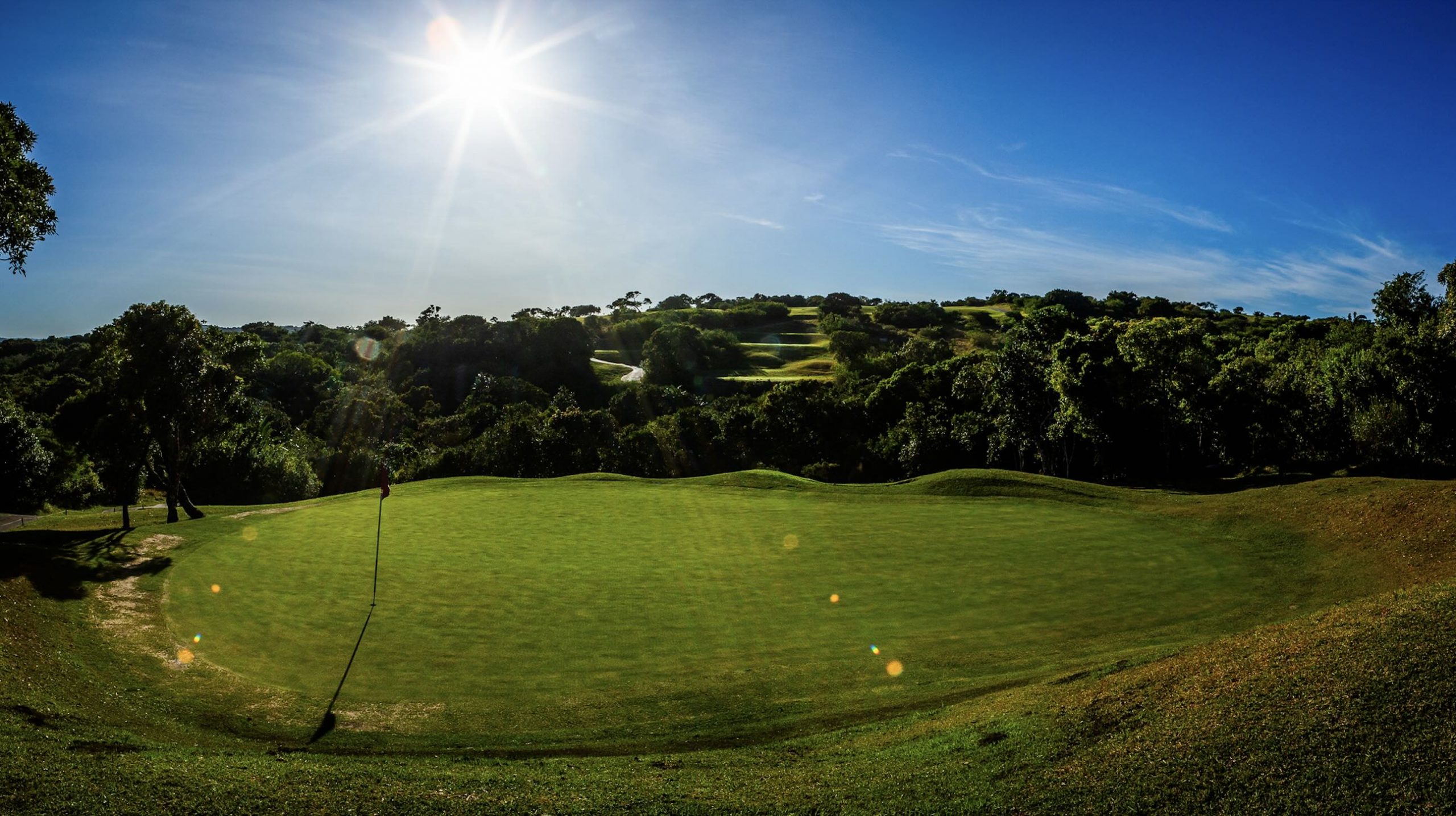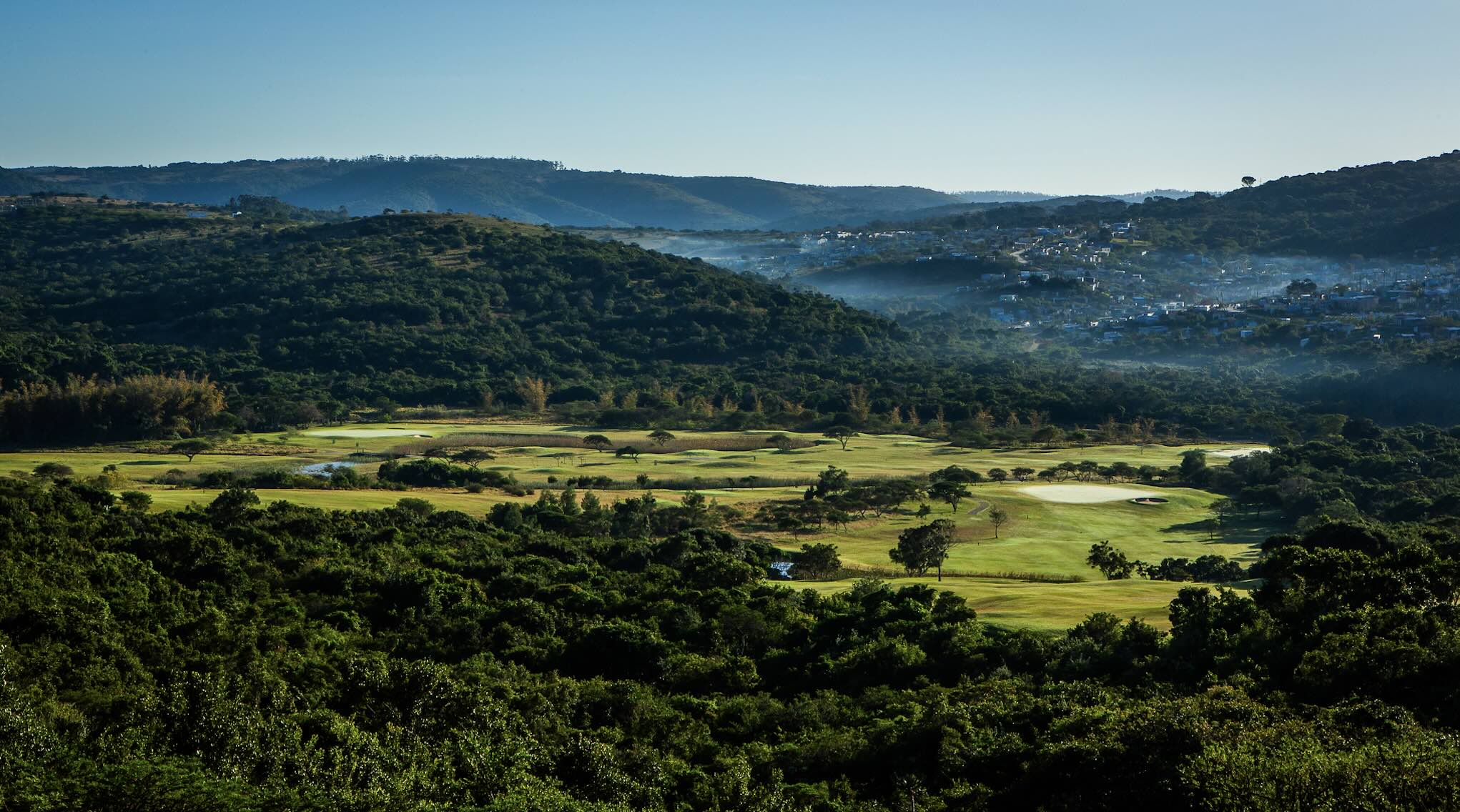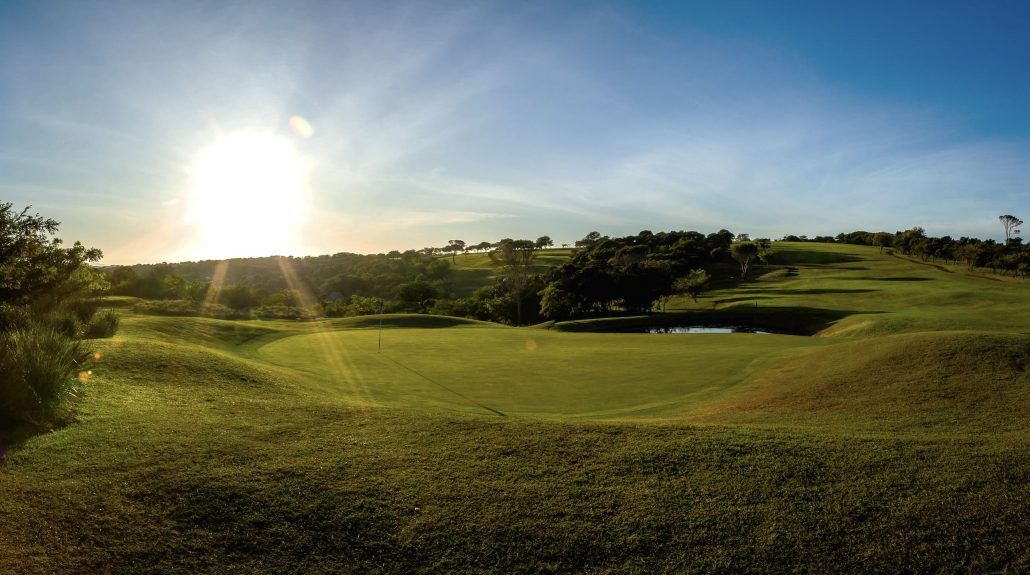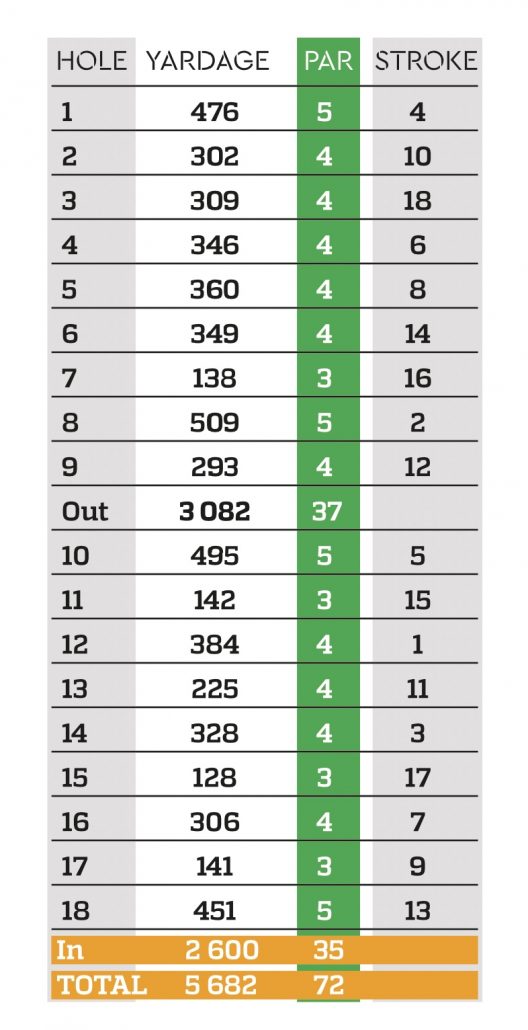Carved out of Wild Coast vegetation on hillsides above the sea, the golf course at Olivewood Estate, just half-an-hour outside East London, shows its character from the very first tee box, writes MIKE GREEN.
Although it’s technically not on the Wild Coast – it only just misses out – this part of the coast in the Eastern Cape is reminiscent of all things wild, and the beauty of the surrounds is the reason so many seek out this peaceful spot that claims its name from the river on which it lies, meaning ‘crumbling banks’ in isiXhosa. It is situated near the quaint little seaside village of Cintsa (or Chintsa).
For a newcomer to any course, the sight of a direction marker as the ground falls away creates a degree of fear as to how the fairway will look down the hill. In truth, the fairway is relatively generous, and the rough left and right is relatively light. But the opener is not a high stroke rating for nothing; golfers of all abilities must beware of the small dam and the well-placed bunkers that guard the elevated putting surface.
It’s that hill which is so characteristic of Olivewood, which is an out-and-back layout. There are ups and downs aplenty, with the first eight holes tumbling downhill into the Chintsa River plain and tidal lagoon before climbing back uphill and returning to the clubhouse. And when some of those hills are married with the step-like effect found on some of the fairways, there are many holes which demand so much more than getting it out a long way off the tee.
And, as the course has settled in, it has become a fairer test than it was with the rough left high, and the challenge is one to relish for all levels of player.
It is in pleasant surroundings, too. Olivewood possesses a beautiful single-storey clubhouse with wide-open colonial verandahs, modelled on the 1920s farm-house belonging to the Schafli family, one of the four original farms on which the estate now stands.
It also has a wonderful restaurant, Governors House, attached, with a small but interesting menu. A boutique hotel was opened in December 2019 alongside the 18th hole with 24 spacious ground-floor villa-type rooms. A new Residence Club opened in December last year, featuring a leisure room, gym, spa and pool for estate residents and hotel guests.
It’s a big walk, despite measuring 6,200m from the back tees and 4,900m from the front tees. That means golf carts are required to get around, but some golfers do walk. However, there are several steep climbs from the 12th green to the 17th tee where you might regret not having a cart.
Just down the road from the parking lot for the clubhouse, there is a 240m practice range with grass bays. The short-game facility is just in front of the clubhouse, and it has a large putting green which is a good place to spend some time ahead of your round.
Back on the course, once the 1st hole is in the books, the 2nd poses some of the challenges that make just about every hole something of a conundrum. After the downhill of the 1st, the 2nd climbs up from the tee shot down in a valley to a fairway that rises with links-like undulations and then turns sharp left towards the green. The fairway has been described as ‘a grass waterfall, gently cascading into the dam below’.
This is the intimidating impression golfers have as they ready themselves for a tee shot that must clear a deep gully with heavy bush on the right and a large dam on the left. With the tee forward, longer hitters can take the risk of going for the green. The golfer preferring a cautious approach on this hole should look to play up the right of the fairway into the bottleneck, which then turns hard left and will leave wedge in for the second shot.
It’s only when you leave the 2nd that you start relaxing into the round, with the stroke-18 3rd giving you a chance to breathe as you continue the downhill journey to the bottom of the property.
The 4th marks the start of a challenging stretch again, with an approach down a steep slope and a sloping green which threatens a three-putt if you don’t leave yourself with an uphill first putt. The 5th is the kind of hole that leaves you wishing for warm, windless conditions. With three fairway bunkers awaiting drives that are slightly off line, you are once again required to approach the green at the bottom of a sloped fairway. The sloping green threatens a three-putt if you don’t leave yourself an uphill first putt.
After the apparently simple stroke-14 6th – which is deceptive, because the narrow, slightly sloping fairway challenges shorter hitters and longer hitters alike – players are taken to the first of the par threes. The 7th has a superb view of the village at Chintsa East, the river and the lagoon. It plays steeply downhill to a putting surface that looks flat but has plenty of subtle movement which can often be perplexing when you miss something which seems straightforward.
The 8th takes you down to the bottom of the property, with a knee-trembler of a tee shot, a head-scratcher of a second and more putting posers as you start a little meander around down at the low point of the course (see Signature Hole, below).
The uphill 9th eases you towards the halfway house, and – with a wide fairway – a big drive will leave a short approach and a good feeling for whatever your midway libation happens to be. Just don’t be long with that approach, as there is a dam waiting to snaffle up anything overly ambitious.
The par-five 10th is a beauty: Everything about it from the tee is inviting, and hitting driver and keeping it right feels easy. The second over the water which crosses the fairway diagonally is still a longish one after a good drive, and this time, you have to stay left as the water continues up the right side of the second part of the fairway. It’s a short approach if all has gone well after that. There’s a small bunker guarding the generously sized green, and that seems as good a way as any to start a back nine.
The par-three 11th is a short one with water short and left, and, with the prevailing wind generally a crosswind, it’s reassuring to have a decent bail-out area on the right.
The 12th is the stroke one, and the tee shot quickly makes it very clear that keeping things straight is paramount. Out of bounds right and trouble left on the longest par four on the course make it essential that you keep your wits about you. Get it off the tee well, and you will still have to take one more than you think is necessary for your approach with the steep uphill short of the green. Your putting will again be tested, especially if you find yourself on the wrong side of the green, which has split levels.
Then it’s on to the 13th. You probably have been eyeing it out during your halfway break, and for good reason: It’s the shortest and steepest par four on the course, and, once you work out the angles, you have a decision to make. The fairway is reminiscent of the 2nd, and, if you want to take the Tiger line, you’re going to miss all of that and have just 215 to the front of the green from the back tee. Longer hitters need to take a risk on this hole.
From the tee it seems a daunting shot, but once up by the green, many a player is left rueing the chance they wasted. Plenty of space around the green allows you to miss it slightly and still be in a great position for your second to the green. As befits a short hole like this, the green is a true test of putting prowess, so finding the correct portion of the green with your approach is paramount.
Get the stroke-three 14th out of the way with a good drive, and an uphill approach to the green, and you move on to what is widely considered the signature hole of the course. In truth, much of that reputation lies in the way the 15th looks. The tees and green are on opposite slopes of a deep, formidable, forested ravine which leaves players with only one option: clear the hazard or hit another tee shot. Hitting the green is paramount. Make sure you carry both the dense bush in front of the tee, and the two deep bunkers short of the green.
It is better to be long rather than short on this hole, with a steep embankment behind the green helping any ball that is overhit back towards the green. This is one of the hardest greens on the course to putt on, so keep a steady stroke.

With a pinched fairway in the landing area, the 16th is reminiscent of the 14th. It also has an elevated green, but this one bends left instead of to the right. If you leave yourself with a longish second – and that is advisable – you could bail out right, but you will need to steer clear of a bunker placed precisely for such a timid move.
The final par three demands some fairly precise distance control, as short and long will find you in deep bunkers, which make a par on this hole impossible.
On to the last hole, and a short par five is just the kind of finish that makes that post-round drink taste even better. Open your shoulders and hit driver, firstly because it is your last hole and secondly because there is no real danger off the tee, except the two fairway bunkers. The best line is on the right of the fairway as it helps open the gap up between the trees on this dogleg left. For your second shot there is no real danger, so lay-up to your favourite distance. The third shot will need to be placed expertly. A bunker protects the green on the right and thick rough surrounds a putting surface with many levels. Concentration is important so that you do not end your round with a three-putt.
Depending on when you finish your round, the verandah is a good place for breakfast, lunch or sundowners, and to reflect on what you have seen and how you have played.
SIGNATURE HOLE
8th hole, par five, 509m

The tee complexes on the 8th are one of the most attractive and memorable features of this stunning hole.
For starters, this is one of the longest holes at sea level in South Africa. With a long path winding along the side of the hill, linking the various teeing grounds with clever switchbacks, it is your drive that determines your score on this par five.
Controlling your fear is how you play this hole for the first time. A 3-wood or long-iron to the right side of the U-shaped gap in the trees is the target for your first shot. Watching the ball run right to left down the hill towards the levelled slopes is the best outcome.
Your second shot will again need a 3-wood or long-iron to clear the dam and set you up for the easiest of third shots.
After crossing the dam, you will have just a wedge to a green with only one bunker short and right to protect it. As always, putting is a key feature, as subtle breaks are found in all parts of the green.
GREENFEES
Members: 18 holes R175 9 holes R115
Member’s guest: 18/R260 9/R130
Member student: 18/R120 9/R95
Visitor affiliated: 18/R360 9/R230
Non-affiliated: 18/R420 9/R250
Cart hire: 18/R330 9/R220
GETTING THERE
(From East London Airport)
26.9km: Get onto Settlers Way/R72 (280m). Continue on R72. Take N2 to Schalfli Road (27.7km). Follow Schafli Road to the destination (16.6km)
ADDRESS
Schafli Road, Chintsa East, East London, Eastern Cape
ROAD DISTANCES
East London: 36km
Gqeberha: 326km
Bloemfontein: 588km
Durban: 629km
Kimberley: 740km
Sandton: 995km
Pretoria: 1 037km
Cape Town: 1,071km
CONTACT DETAILS
Phone: 087 350 4310
Email: [email protected]
Website: olivewoodestate.com
– This article first appeared in the February 2024 issue of Compleat Golfer magazine.










